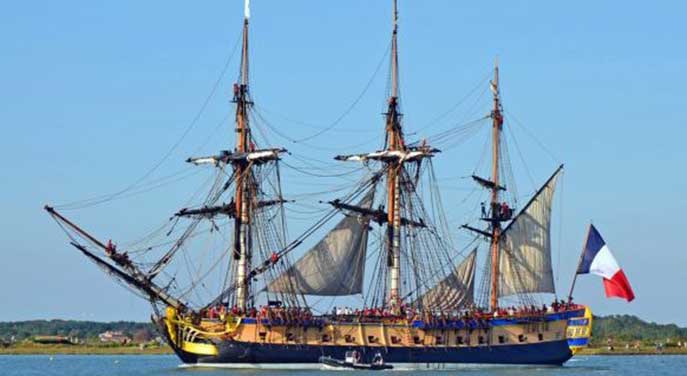 From the very beginning, the cognac industry was dominated by cognac houses that acted as intermediaries between the producers of eau de vie and their overseas markets.
From the very beginning, the cognac industry was dominated by cognac houses that acted as intermediaries between the producers of eau de vie and their overseas markets.
Many of the first cognac houses were founded by English and Irish entrepreneurs: Jean Martell was from Jersey, while Isaac Ransom, James Delamain and Richard Hennessy were all Irishmen.
Thomas Hine and Anthony Hardy were both from England. French entrepreneurs included Paul-Emilie Rémy Martin, Jean-Baptiste Otard and Alexandre Bisquit, Felix Courvoisier and Jean-Baptiste Camus.
The cognac houses, at first, didn’t own any vineyards or distilleries. They were blenders and shippers. They purchased eau de vie from many producers and fashioned it into a house brand of cognac that they then exported.
This was the same industry structure that had emerged in the port trade in Portugal or the wine trade on Madeira. It was export sales that drove the development of the industry, a feature as true today as it was three centuries ago.
By the end of the 18th century, there were 10 houses in Cognac exporting to North America and Europe.
The first export sales to the then-fledging United States were by Martell in 1784. Ten years later, they were joined by Hennessy. About that time, cognac began to appear in Halifax, although this was probably re-exports from Great Britain.
It’s likely, however, that cognac reached the New World long before.
 One of British America’s favourite libations was a drink called cherry bounce. It was a favourite of George Washington, who often carried a flask of it when he was travelling. Martha Washington’s original recipe was discovered at Mount Vernon a few years ago.
One of British America’s favourite libations was a drink called cherry bounce. It was a favourite of George Washington, who often carried a flask of it when he was travelling. Martha Washington’s original recipe was discovered at Mount Vernon a few years ago.
The recipe calls for mixing the juice of six cups of cherries, preferably sour morello cherries, with one quart of cognac. The mixture was then gently heated and two cups of sugar were stirred in. It was then flavoured with cinnamon, cloves and nutmeg.
The earliest published recipe for cherry bounce dates to 1732. Colonials were also fond of another cognac-based drink called fish house punch. It also dates to the early 18th century.
In 1780, the Marquis de Lafayette made his second trip to the American colonies. His ship, L’Hermione, carried numerous casks of cognac, so it is certain that cognac was available in Washington’s military camp. Hennessy believes that some of the cognac brought by Lafayette was from their cellars.
In 2015, as part of their 250th anniversary celebration, they commissioned a replica of L’Hermione to recreate Lafayette’s journey, complete with casks of Hennessy Cognac. The cognac was eventually auctioned off for charity.
Export sales to Asia also figured prominently in cognac’s growth. By 1850, cognac was being exported to Australia. By 1859, it could be found in India and China. It’s likely, however, that cognac was being re-exported from Great Britain to her colonies long before the start of official shipments.
The French-Russian military alliance of 1894 made all thing Russian, from vodka to caviar to the Ballets Russes, the height of fashion in Paris. It had a reciprocal effect in Russia. By 1896, Martell and Hennessy were exporting cognac to Russia, and cognac had replaced vodka as the preferred drink at the Imperial Palace in St. Petersburg.
Cognac was the first spirit to cater to a global market. By the second half of the 19th century, rum, especially Barbados rum, and Irish whiskey had also developed worldwide footprints, but these were centred on the British dominions.
They were global only because the British empire was global. Outside of the empire, however, both spirits’ market penetration, except for the United States, was quite low. When Irish whiskey distillers lost access to their markets in the British Empire following Irish independence in 1922, for example, their whiskey sales cratered.
Cognac’s worldwide dominance came crashing down in the wake of the phylloxera crisis. Scotch whisky distillers quickly took advantage of the opportunity and have never looked back. There’s little data on each spirit’s market share at the end of the 19th century, however, so comparisons to the current period are difficult.
Between its pre-phylloxera peak and today, sales of cognac by volume have tripled. In 2016, sales reached the equivalent of about 189 million bottles. Scotch whisky’s worldwide sales, however, exceeded 1.2 billion bottles. Measured in volume, Scotch whisky has a market share more than six times greater than cognac.
Revenue-wise, the comparison is narrower, reflecting cognac’s higher average price. The Scotch whisky export market is about $5.5 billion in size versus the cognac market at around $3.5 billion. That still makes the Scotch whisky market about 60 per cent bigger than cognac. Cognac is exported to about 150 markets around the world. The comparable figure for Scotch is more than 200.
In the mid-18th century, Paris consumed more cognac than the rest of the world combined. A century later, however, France’s share of the cognac market had dropped to around 10 per cent. Great Britain had grown to about 80 per cent of the cognac market, some portion of which was re-exported. Today, France consumes about 2.5 per cent of the cognac produced, with the balance being exported.
In the United States, during the 19th century, cognac was the drink of polite society and the growing urban middle class. Most cocktails were cognac-based. Jerry Thomas’s Bartenders Guide, published in 1862, the first compendium of cocktails, featured largely cognac-based drinks. Often, versions featuring rye- or corn-based whiskey were offered as cheaper alternatives. Even the mint julep, bourbon country’s signature cocktail, was originally made with cognac rather than bourbon.
Cognac was first shipped to China in 1859, although which brand is not clear. Martell first exported cognac to Shanghai in 1861. Official shipments to Hong Kong started at about the same time, although cognac, likely re-exported from Great Britain, was there from the 1840s.
Initially, it was consumed by European expatriates living there, but it quickly became a preferred drink of middle-class and elite Chinese in the coastal cities.
Imports continued even after the communist revolution in 1949 but the quantities were tiny. When China began opening up, however, cognac producers found a ready market there.
Cognac’s potential in China is vast. Roughly 99 per cent of spirits sales by volume and 94 per cent by revenue in China are locally produced spirits, mostly baijiu. The rest of the world competes fiercely for the tiny sliver that’s left.
China is cognac’s third-largest market by volume but has, on a number of recent occasions, been its largest by revenue. That’s astounding considering that cognac has only a .5 per cent share of China’s spirit market. Whiskies from all countries have a 2.5 per cent market share by comparison. Since the turn of the century, Chinese cognac imports have increased around 20-fold.
Joseph V. Micallef is an historian, best-selling author, keynote speaker and commentator on wine and spirits. Joe holds the Diploma in Wine and Spirits and the Professional Certificate in Spirits from the Wine and Spirits Education Trust (London).
Joseph is a Troy Media Thought Leader. For interview requests, click here.
The views, opinions and positions expressed by columnists and contributors are the authors’ alone. They do not inherently or expressly reflect the views, opinions and/or positions of our publication.
© Troy Media
Troy Media is an editorial content provider to media outlets and its own hosted community news outlets across Canada.

